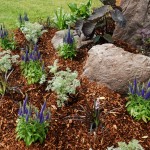 Thinking of re-landscaping? Use mulch to cover bare spots on the ground.
Thinking of re-landscaping? Use mulch to cover bare spots on the ground.
Mulch does so much for the ground besides just making it look good. Mulch keeps moisture in, by limiting evaporation. Mulch breaks down and provides nutrients for the soil, which plants use to grow. Decomposed mulch can help the soil retain moisture as a water storage medium and its all natural.
Lots of people with clay soils want to add as much mulch as they can to help improve the quality of their soil. Compost helps too.
Mulch can be found in many different varieties – Home Depot has a vast assortment of mulch available – the best kind is free from the back of a tree trimming truck. Many tree trimming companies will be willing to leave 5-10 yards of wood chips on your driveway at the end of their day – just make sure you have the means to move it.
A widely popular film in the gardening world is “Back To Eden” (http://www.backtoedenfilm.com/) where gardener Paul Gautsch gardens with mulch (wood chips) and he uses very little irrigation water (of course he also lives in Washington where it rains all the time), but he extolls the virtue of mulch in the garden. The video is worth an hour of your time and it will leave you wanting mulch for your yard.
But this is a RecycledH2O blog – so why should we care?
When you’re looking to re-landscape your yard, you may be looking to remove your lawn and put in plants or trees. Mulch is key to keep the moisture in the ground, which will allow you to use much less water than your lawn would have. RecycledH2O in this case could be your watering source – it flows through the voids left by mulch and will reach the soil below.
To hammer this point home, I did an experiment in two identical planter boxes in my back yard.
The Setup
I have two identical plastic planter boxes – measuring about 2 feet long, 1 foot tall, 1 foot wide. They have the same soil and the same pepper plants. They are both in full sun.
For this test I am using 4 – 750ml empty wine bottles which are filled with rainwater (recycledh2o would be fine too) and stuck inside a ceramic plant nanny. If you haven’t seen these before – invest in them. A set of 4 costs ~ $18 on Amazon. I’ve been using them for years with my potted plants – well worth it – especially if they’re not hooked up to an automatic sprinkler system.
They work by providing moisture to the soil when it needs it. It uses the water from wine bottle upside down in the stake.
In one planter box I have 3 pepper plants with no mulch on top of the soil. In the other I have 3 pepper plants with mulch on top of the soil. The mulch is from shredded bushes/trees and shrubs.
I took a photo of the planter boxes each day – except for day 6 and 7 as I was out of town – the stakes kept watering – you’ll see the water drop.
I stopped doing the test when one of the wine bottles was empty. That took 9 days. I never watered with a watering can to either box and let nature handle everything else.
Water level is depicted by the red arrow.
| Mulch on top of soil | No Mulch on top of soil | |
| Day 1 | 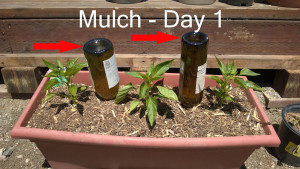 |
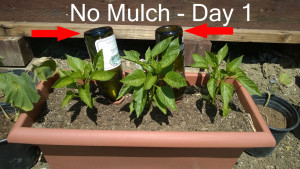 |
| Day 2 | 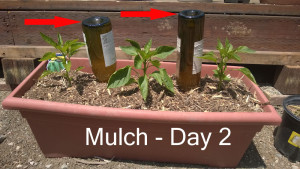 |
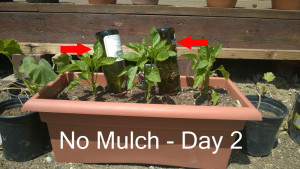 |
| Day 3 | 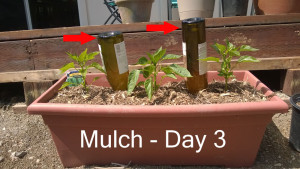 |
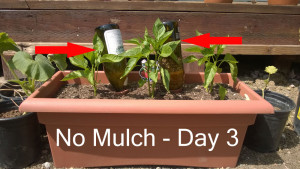 |
| Day 4 | 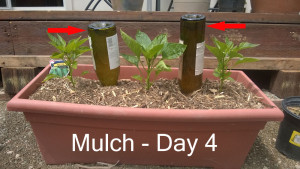 |
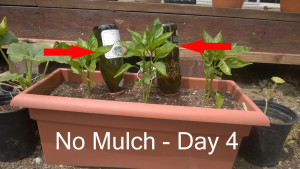 |
| Day 5 | 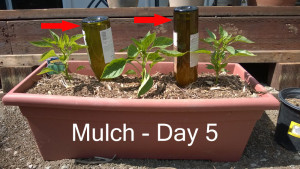 |
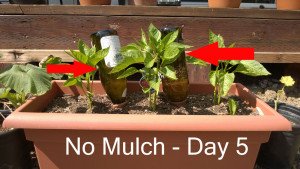 |
| Day 6/7 | Missing | Out of town |
| Day 8 | 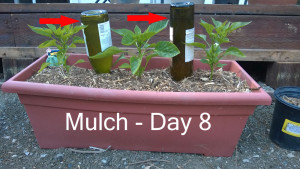 |
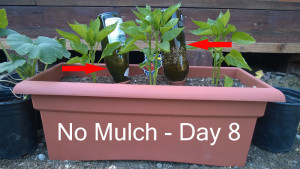 |
| Day 9 | 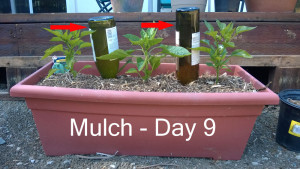 |
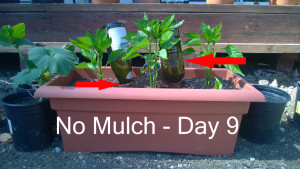 |
Results
As you can see by the photo series above – the water level in the bottles in the mulch barely dropped while the wine bottles with no mulch covering dropped pretty significantly each day. Its been a week since I ran the results and the mulch covered bed still hasn’t used much water. Where as in the non-mulch boxes I re-filled the other bottle and am already half way through the first.
So what did we learn?
Mulch does help keep moisture in the soil by severely limiting evaporation which lowers the need to water.
In 9 days – the mulch covered bed used barely a cup of water while the no mulch covered bed used almost 1.5 liters of water. All 6 plants grew about the same amount and are both healthy.
Water savings ~ 80%.
1 cup is equal to about 236 ml. If one wine bottle is 750, and 2/3’s of the second bottle was used up, then 1200 ml of liquid is in the non-mulch box. 236ml (mulch) /1200ml (non mulch) = 19.6% water for mulch bed or 80% water usage for non-mulch bed.
Small Update:
I rediscovered this graphic which coincides with my findings of 80% water savings through mulching. Ironically – I didn’t even refer to this when I ran my experiment – but here goes. I don’t remember where I found the graphic but felt it was totally worth saving at the time.
More Information
- Landscape mulch 101 – http://landscaping.about.com/cs/compostandmulch/a/mulches.htm
- How to Use Mulch in Landscaping – http://www.gardenguides.com/82506-use-mulch-landscaping.html
- Houzz – Landscaping with Mulch – http://www.houzz.com/landscaping-with-mulch
- Back to Eden – http://www.backtoedenfilm.com/how-to-grow-an-organic-garden.html

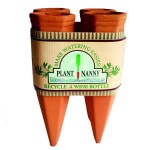
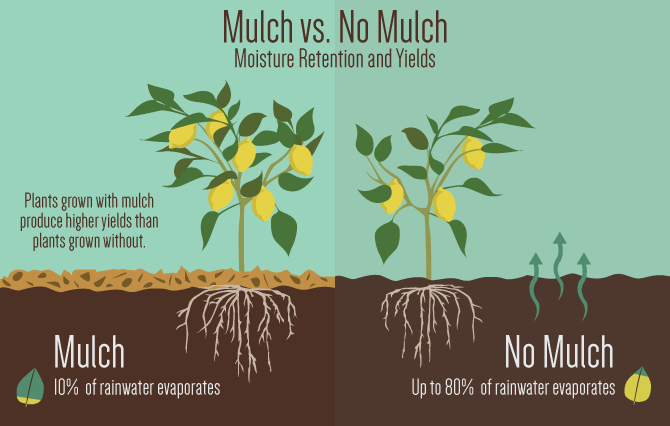
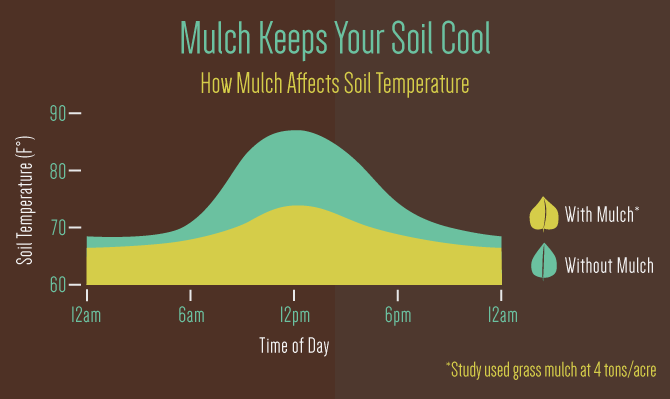








0 Comments
1 Pingback